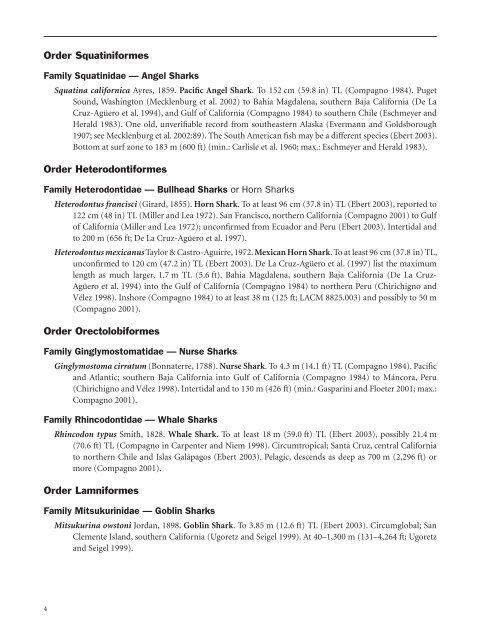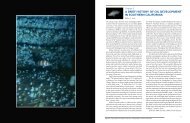- Page 2 and 3: Resource Inventory of Marine and Es
- Page 5 and 6: ACKNOWLEDGMENTS This West Coast inv
- Page 7 and 8: 2) Regional guides. In most instanc
- Page 9: Some readers may question the capit
- Page 12 and 13: Order Chimaeriformes Family Chimaer
- Page 16 and 17: Isurus oxyrinchus Rafinesque, 1810.
- Page 18 and 19: Carcharhinus leucas (Müller & Henl
- Page 20 and 21: Narcine entemedor Jordan & Starks,
- Page 22 and 23: Bathyraja parmifera (Bean, 1881). A
- Page 24 and 25: Urotrygon aspidura (Jordan & Gilber
- Page 26 and 27: Order Elopiformes Family Elopidae
- Page 28 and 29: Gymnothorax castaneus (Jordan & Gil
- Page 30 and 31: *Herpetoichthys fossatus (Myers & W
- Page 32 and 33: Chiloconger dentatus (Garman, 1899)
- Page 34 and 35: Family Monognathidae — Onejaws or
- Page 36 and 37: Pliosteostoma lutipinnis (Jordan &
- Page 38 and 39: Ariopsis platypogon (Günther, 1864
- Page 40 and 41: Family Opisthoproctidae — Barrele
- Page 42 and 43: *Maulisia acuticeps Sazonov, 1976.
- Page 44 and 45: Coregonus pidschian (Gmelin, 1789).
- Page 46 and 47: Diplophos taenia Günther, 1873. To
- Page 48 and 49: Bathophilus brevis Regan & Trewavas
- Page 50 and 51: Benthalbella linguidens (Mead & Bö
- Page 52 and 53: Stemonosudis macrura (Ege, 1933). P
- Page 54 and 55: Diaphus anderseni Tåning, 1932. Lo
- Page 56 and 57: Nannobrachium hawaiiensis Zahuranec
- Page 58 and 59: Tarletonbeania taylori Mead, 1953.
- Page 60 and 61: Family Ophidiidae — Cusk-eels Bas
- Page 62 and 63: Family Bythitidae — Livebearing B
- Page 64 and 65:
comm. to C. W. M.) to southern Cali
- Page 66 and 67:
British Columbia (Peden 1975), and
- Page 68 and 69:
Porichthys myriaster Hubbs & Schult
- Page 70 and 71:
Family Oneirodidae — Dreamers Ber
- Page 72 and 73:
Family Gigantactinidae — Whipnose
- Page 74 and 75:
Baja California (Collette in Fische
- Page 76 and 77:
Oxyporhamphus micropterus (Valencie
- Page 78 and 79:
Melamphaes macrocephalus Parr, 1931
- Page 80 and 81:
Herald 1983; max.: Hayashi in Nakab
- Page 82 and 83:
Syngnathus californiensis Storer, 1
- Page 84 and 85:
Scorpaena sonorae Jenkins & Everman
- Page 86 and 87:
Sebastes crameri (Jordan, 1897). Da
- Page 88 and 89:
Sebastes melanostomus (Eigenmann &
- Page 90 and 91:
Sebastes rufus (Eigenmann & Eigenma
- Page 92 and 93:
Prionotus ruscarius Gilbert & Stark
- Page 94 and 95:
Family Cottidae — Sculpins Archis
- Page 96 and 97:
Clinocottus globiceps (Girard, 1858
- Page 98 and 99:
Gulf of Alaska at Prince William So
- Page 100 and 101:
Myoxocephalus niger (Bean, 1881). W
- Page 102 and 103:
Rastrinus scutiger (Bean, 1890). Ro
- Page 104 and 105:
Family Hemitripteridae — Sailfin
- Page 106 and 107:
Agonomalus mozinoi Willimovsky & Wi
- Page 108 and 109:
authors do not recognize the aix fo
- Page 110 and 111:
Eumicrotremus asperrimus (Tanaka, 1
- Page 112 and 113:
Careproctus colletti Gilbert, 1896.
- Page 114 and 115:
*Crystallichthys mirabilis Jordan &
- Page 116 and 117:
Liparis rutteri (Gilbert & Snyder,
- Page 118 and 119:
108 recently been collected from th
- Page 120 and 121:
*Cephalopholis panamensis (Steindac
- Page 122 and 123:
Mycteroperca xenarcha Jordan, 1888.
- Page 124 and 125:
Family Apogonidae — Cardinalfishe
- Page 126 and 127:
Family Carangidae — Jacks Alectis
- Page 128 and 129:
Hemicaranx zelotes Gilbert, 1898. B
- Page 130 and 131:
Family Bramidae — Pomfrets Brama
- Page 132 and 133:
Family Lobotidae — Tripletails Lo
- Page 134 and 135:
124 Haemulon scudderi Gill, 1862. G
- Page 136 and 137:
Family Polynemidae — Threadfins P
- Page 138 and 139:
Gulf of California (Chao in Fischer
- Page 140 and 141:
Family Chaetodontidae — Butterfly
- Page 142 and 143:
Cirrhitus rivulatus Valenciennes, 1
- Page 144 and 145:
Zalembius rosaceus (Jordan & Gilber
- Page 146 and 147:
Cabo San Lucas, southern Baja Calif
- Page 148 and 149:
*Scarus compressus (Osburn & Nichol
- Page 150 and 151:
Eucryphycus californicus (Starks &
- Page 152 and 153:
Lycodapus fierasfer Gilbert, 1890.
- Page 154 and 155:
Lycodes raridens Taranetz & Andrias
- Page 156 and 157:
Anisarchus medius (Reinhardt, 1837)
- Page 158 and 159:
Lumpenus fabricii Reinhardt, 1836.
- Page 160 and 161:
Rhodymenichthys dolichogaster (Pall
- Page 162 and 163:
Axoclinus storeyae (Brock, 1940). C
- Page 164 and 165:
Kali macrura (Parr, 1933). Longnose
- Page 166 and 167:
Starksia guadalupae Rosenblatt & Ta
- Page 168 and 169:
Family Blenniidae — Combtooth Ble
- Page 170 and 171:
*Tomicodon boehlkei Briggs, 1955. C
- Page 172 and 173:
Eucyclogobius newberryi (Girard, 18
- Page 174 and 175:
Family Ephippidae — Spadefishes C
- Page 176 and 177:
Family Trichiuridae — Cutlassfish
- Page 178 and 179:
Scomber japonicus Houttuyn, 1782. C
- Page 180 and 181:
Family Nomeidae — Driftfishes or
- Page 182 and 183:
Citharichthys gordae Beebe & Tee-Va
- Page 184 and 185:
Family Pleuronectidae — Righteye
- Page 186 and 187:
Lyopsetta exilis (Jordan & Gilbert,
- Page 188 and 189:
178 Lavenberg 1997). Benthic, at de
- Page 190 and 191:
Family Ostraciidae — Boxfishes La
- Page 192 and 193:
REFERENCES CITED Aasen, G. A., D. A
- Page 194 and 195:
Andriashev, A. P. 1958. An addition
- Page 196 and 197:
Bertelsen, E., T. W. Pietsch, and R
- Page 198 and 199:
Castro-Aguirre, J. L., H. Espinosa
- Page 200 and 201:
Craig, P. and L. Haldorson. 1986. P
- Page 202 and 203:
Evseenko, S. A. 1999. Early develop
- Page 204 and 205:
Gartman, R. and A. Groce. 1998. Dem
- Page 206 and 207:
Harold, A. S. 1993. Phylogentic rel
- Page 208 and 209:
Jordan, D. S. and B. W. Evermann. 1
- Page 210 and 211:
Kushner, D. J., D. Lerma, J. Shaffe
- Page 212 and 213:
Lissner, A. L. and J. H. Dorsey. 19
- Page 214 and 215:
Mecklenburg, C. W. 2003. Family Zap
- Page 216 and 217:
Myers, R. F. 1999. Micronesian reef
- Page 218 and 219:
Orr, J. W., M. A. Brown, and D. C.
- Page 220 and 221:
Peden, A. E. and D. E. Wilson. 1976
- Page 222 and 223:
Richards, D. V. and J. M. Engle. 20
- Page 224 and 225:
Schmidt, P. J. 1950. Fishes of the
- Page 226 and 227:
Stein, D. L. 1978. A review of the
- Page 228 and 229:
Tokranov, A. M. and A. M. Orlov. 20
- Page 230 and 231:
Wilimovsky, N. J. 1954. List of the
- Page 232 and 233:
PERSONAL COMMUNICATIONS Alisa A. Ab
- Page 234 and 235:
Index A Ablennes hians, 63 Abudefdu
- Page 236 and 237:
Index Apogonidae, 114 Apogon atrica
- Page 238 and 239:
Index Basketweave Cusk-eel, 51 Bask
- Page 240 and 241:
Index Black (continued) Bobtail Eel
- Page 242 and 243:
Index C C-O Sole, 176 C-O Turbot, 1
- Page 244 and 245:
Index Cheilotrema saturnum, 126 Che
- Page 246 and 247:
Index Cowcod, 77 Cow Sharks, 2 Craf
- Page 248 and 249:
Index Dipline Eelpout, 144 Diplobat
- Page 250 and 251:
Index Eulachon, 33 Euleptorhamphus
- Page 252 and 253:
Index Giant (continued) Sea Bass, 1
- Page 254 and 255:
Index Halfspotted Tonguefish, 178 H
- Page 256 and 257:
Index Ichthyapus selachops, 20 Icht
- Page 258 and 259:
Index Lestidium johnfitchi, 41 nudu
- Page 260 and 261:
Index Lycenchelys (continued) jorda
- Page 262 and 263:
Index Microlophichthys microlophus,
- Page 264 and 265:
Index Netdevils, 59 Netdevil Angler
- Page 266 and 267:
Index P Pachycara bulbiceps, 145 gy
- Page 268 and 269:
Index Paralonchurus goodei, 128 Par
- Page 270 and 271:
Index Popeye Blacksmelt, 29 Cataluf
- Page 272 and 273:
Index Red (continued) Scorpionfish,
- Page 274 and 275:
Index Samoa Sawtooth Eel, 23 Sandfi
- Page 276 and 277:
Index Seriola dorsalis, 119 lalandi
- Page 278 and 279:
Index Smalleye Snipe Eel, 21 Square
- Page 280 and 281:
Index Spotted (continued) Grouper,
- Page 282 and 283:
Index Tan Bristlemouth, 35 Tapertai
- Page 284 and 285:
Index U Ulca, 94 Ulcina olrikii, 98
- Page 286:
Index Y Y-Prickleback, 147 Yellow-m




